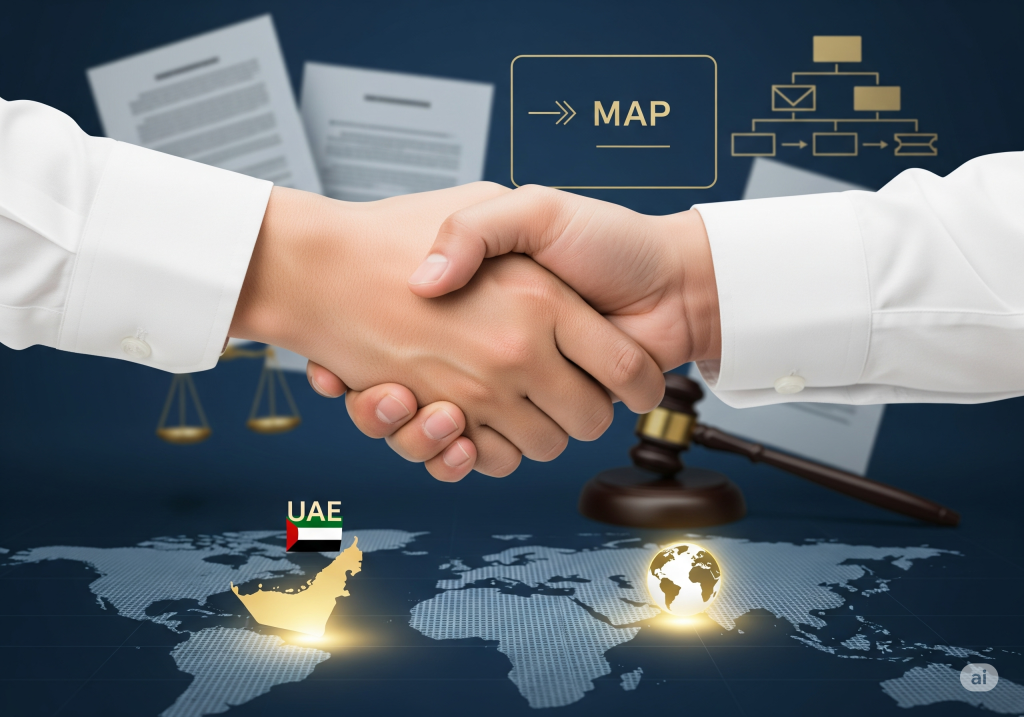UAE Mutual Agreement Procedure Guidance
Navigating taxes in one country is complicated enough. When you’re dealing with two, it can feel overwhelming. If you believe you’re being taxed unfairly or twice on the same income due to conflicting rules between the UAE and another nation, there’s a dedicated process to sort it out.
It’s called the Mutual Agreement Procedure (MAP), and the UAE’s Ministry of Finance has created a clear path for taxpayers like you. Think of it as a formal but friendly negotiation between countries, with the sole aim of making sure you only pay the tax you’re legally supposed to.
This guide breaks down what you need to know in simple terms.
What is MAP and When Can I Use It?
MAP is a safety net (mechanism). It’s built into over 100 tax treaties the UAE has with other countries. You can use it to resolve disagreements like:
- (a) Double Taxation: One of the biggest problem is when both the UAE and another country hit you with taxes on the very same income. You see this a lot with what’s called “transfer pricing,” which is basically how big companies decide what to charge when their different international branches do business with each other.
- (b) Residency Conflicts: When two countries both claim you as a tax resident.
- (c) Business Profit Disputes: Disagreements over how much of your business’s profit should be taxed in the UAE versus another country.
Essentially, if you’re a person or a company facing taxation that doesn’t seem to follow the rules of a tax treaty, MAP is your official route to a fair solution.

MAP Process
The journey to resolving your tax issue has a clear structure. Here’s how it works:
Step 1: Do I Qualify? Before anything else, you’ll need to be sure your situation fits the bill. Are you being taxed in a way that goes against a specific UAE tax treaty? If the answer is yes, you can move forward.
Step 2: Starting Your Claim It’s time to gather your documents and officially ask for help.
- (a) What you’ll need: Think of it like building your case for court. You need to gather all your ducks in a row. That means you’ll need a ton of details about yourself or your company, the other country involved, and the exact article in the tax treaty you think is being ignored. Don’t forget to specify which tax years you’re talking about, too.
You’ll also need to gather all the important paperwork. We’re talking about things like your tax assessments, any transfer pricing reports you have, and solid proof that you’re a resident of your country for tax purposes. These are the documents that will really prove your point.
- (b) Where to send it: Email your complete package to the UAE’s Competent Authority (the official team that handles these cases) at uaemap@mof.gov.ae. All documents should be in English or Arabic.
- (c) Be prompt: Once you file, the Authority will check if your application is complete within two months. If they ask for more information, you have one month to provide it.
Step 3: The Assessment The UAE’s Competent Authority (CA) will check everything within two months to make sure your claim is complete, on time, and has a solid reason behind it.
Step 4: Finding a Solution This is where the problem-solving happens.
- (a) First, the UAE’s Competent Authority (CA) will try to fix the issue on its own—they call this unilateral relief.
- (b) If not, they will start direct negotiations with their counterparts in the other country (Bilateral Negotiation). You provide the facts, but you won’t be at the negotiating table yourself (unless they specifically invite you to clarify something).
Step 5: The Outcome Once a decision is made, you’ll be notified.
- (a) Agreement Reached: You’ll have a month to either accept or turn down the solution they offer. If you accept, you’ll have to withdraw any local lawsuits you’ve filed. After that, the agreement is officially in effect.
- (b) No Agreement: If the two countries can’t agree, the MAP process closes. You’re then free to pursue other options, like going to court.
- (c) Arbitration as a Plan B: Some tax treaties allow for an independent arbitrator to make a final decision if the countries can’t agree. This is an option only if you haven’t already received a final court ruling.
Key Things to Keep in Mind
- (a) Deadlines are Important: You generally have three years from the first time you were notified of the incorrect tax to file a MAP claim. Don’t wait until the last minute!
- (b) MAP vs Courts: You can’t pursue MAP and a domestic court case at the same time. A final ruling from a UAE court will also limit what the MAP team can do for you.
- (c) Taxes Still Due: You must continue to pay your taxes as assessed while the MAP process is ongoing. If the agreement results in you getting money back, it will be processed as a refund.
- (d) Be Responsive: The UAE aims to resolve cases within 24 months, but this depends on you providing complete information and responding to requests within one month.
- (e) You’re in Control: You can withdraw your MAP claim at any time by sending an email.
Who Does What?
- (a) You (The Taxpayer): Your role is to provide a complete, accurate, and well-documented case. The stronger your documentation, the better your chances.
- (b) UAE Competent Authority (at the Ministry of Finance): This is your main point of contact. They are an independent body focused solely on resolving these international disputes fairly.
- (c) Federal Tax Authority (FTA): They are the administrators of the UAE tax system. They support the MAP team with information and are responsible for implementing the final agreement (like issuing a refund).
These folks are the ones running the show when it comes to taxes in the UAE. They’re the go-to source for info, especially for the team handling international agreements. And once a deal is done, they’re the ones who make it happen—like sending you a refund if you’re owed one.



